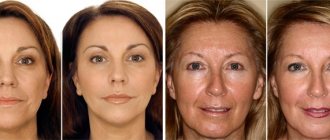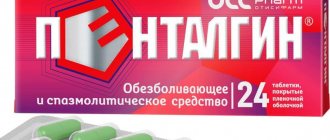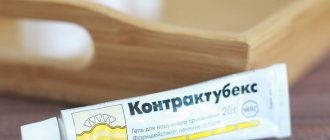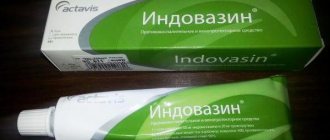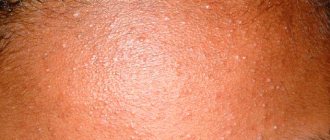From this article you will learn:
- composition analysis,
- detailed instructions for use,
- Solcoseryl gel – reviews, price 2022.
The article was written by a specialist with higher medical education.
Solcoseryl gel is a drug based on deproteinized dialysate from the blood of calves, which accelerates the healing of wounds on the skin and mucous membrane. For example, this drug is widely used in dentistry - to accelerate the healing of erosions and ulcers of the mucous membrane during stomatitis, traumatic injuries to the mucous membrane, and for bedsores under dentures. As for skin wounds, the drug is intended only for the treatment of fresh, wet wounds. To treat wounds and skin damage in the absence of wet discharge, Solcoseryl should be used in the form of an ointment.
The drug is manufactured (Switzerland) and registered as a “medicinal product”. The drug has a high safety profile - in particular, it has no age restrictions, as well as contraindications for use in pregnant and lactating women. When squeezed out of the tube, you can see that the gel is completely transparent, homogeneous and not too liquid (it has a fairly dense consistency). It also has a faint smell of meat broth, which is due to the production technology.
Solcoseryl: photo of packaging
Deproteinized dialysate from calf blood - indications for use
The following list of indications for use is determined by the presence in the drug of deproteinized dialysate obtained from the blood of dairy calves. The dialysate contains a large number of active substances and growth factors that accelerate regeneration processes in the skin and mucous membrane. Indications for use of Solcoseryl gel –
- wet wounds on the skin and red border of the lips,
- trophic ulcers on the skin,
- erosions and ulcers of the oral mucosa,
- bedsores under removable dentures,
- injuries to the mucous membrane from removable and fixed dentures, sharp edges of fillings.
Once again, we draw your attention to the fact that when using the drug on the skin and red border of the lips, the indication for use is only wet wounds. Those. wounds must not be covered with crusts and have a moist discharge. If the wound is covered with dry crusts and there is no wet discharge, then according to the instructions for use, it is necessary to use not a gel, but Solcoseryl in the form of an ointment.
If you plan to treat the oral mucosa, then keep in mind that the gel form is optimal for superficial lesions of the mucous membrane - shallow ulcers, burns, bedsores under dentures. But if the ulcer is deep enough, or you need to cure alveolitis in the hole of an extracted tooth, then in this case it is better to use another form of this drug - Solcoseryl dental paste.
Solcoseryl gel – price, composition analysis
As in the situation with other drugs in the Solcoseryl line, the price for the gel form increased by 3-4 times in 2020-2021. What is the reason for this increase is not entirely clear to me, as a practicing doctor (after all, the drug has a very simple composition). For Solcoseryl gel the price will be from 2000 to 2700 rubles - as of mid-October 2022). The drug is available in aluminum tubes of 20 g. It is sold in pharmacies without a prescription.
Composition of Solcoseryl gel:
| The active substance (per 1 g of gel) is deproteinized dialysate from the blood of healthy dairy calves. | 4.15 mg |
| Excipients - calcium lactate penhydrate, propylene glycol, sodium carmellose, water for injection, as well as preservatives - methyl parahydroxybenzoate (E 218) and propyl parahydroxybenzoate (E 216). | |
Composition analysis - the only active component of the gel is deproteinized dialysate from the blood of dairy calves, which is rich in a large number of low molecular weight organic compounds - amino acids, glycolipids, oligopeptides, nucleosides, etc. Studies have shown that this composition of organic compounds in Solcoseryl gel accelerates the healing process by approximately 30%. The latter is achieved, among other things, by stimulating angiogenesis and fibroblast function in damaged tissues.
Among the auxiliary components, you can pay attention to the preservatives - methyl parahydroxybenzoate (E218) and propyl parahydroxybenzoate (E216). They belong to a class of preservatives called parabens. As part of the gel, they cannot harm the body, but sometimes cause allergic reactions. You should be careful here only if you have severe allergic reactions to cosmetics and oral hygiene products, in which parabens are most often used.
Analogues –
Previously, Russian pharmacies sold the drug Actovegin, identical in composition, in the form of a jelly, which also contained dialysate from the blood of dairy calves (at the moment this form of the drug is no longer sold in Russia). Solcoseryl gel has no other direct analogues, but there are drugs with an excellent composition and similar effects.
All analogues can be divided into 2 groups. The first group of drugs are drugs for external use, intended to accelerate the healing of wounds on the skin (here we include Olazol and Bepanten). Preparations of the second group are products that are intended for use on the moist mucous membrane of the oral cavity (for example, Curasept “ADS 350 Regenerative” and “GengiGel” gel).
- OLAZOL (in the form of an aerosol) - this drug is suitable for accelerating the epithelization of skin wounds. It contains chloramphenicol, sea buckthorn oil and benzocaine (an anesthetic). Moreover, it not only accelerates tissue healing, but also has an antibacterial and analgesic effect, and also reduces the release of exudate from the wound. Due to the presence of an antibacterial effect, the drug can be used to treat infected wet wounds on the skin. The cost of the drug Olazol will be from 220 rubles.
- Cream BEPANTHEN PLUS – because Solcoseryl gel is intended for the treatment of wet wounds, then from the entire line of Bepanten preparations, we can only use Bepanten Plus cream on wet wounds. This drug contains 5% dexpanthenol (a precursor to vitamin B5, which stimulates skin regeneration), as well as the antiseptic chlorhexidine, which has an antimicrobial effect, thereby reducing the risk of infection. It is important that the concentration of chlorhexidine in Bepanten Plus cream is 0.5% (analogs are much lower). On wet wounds, it is most effective to apply the drug on turundas under a bandage - 2 or more times a day. Open treatment of wet wounds will be ineffective. The cost of Bepanten Plus cream is about 470 rubles for a 30 g tube, and a 100 g tube will cost about 950 rubles.
- CURASEPT “ADS 350 Regenerative” gel is designed to accelerate the healing of the oral mucosa. Contains hyaluronic acid to accelerate the healing of ulcers and wounds, as well as the PVP-VA complex, which forms a protective film on wound surfaces and ulcers (this protects their surface from irritants and also accelerates healing). It also contains the antiseptic chlorhexidine 0.5%. The cost of the gel is about 650 rubles - per 30 ml tube. Be careful when purchasing, because... in the Curasept line there is a gel with a similar name, but without hyaluronic acid.
- Oral gel "GengiGel" (GengiGel) is a gel for the mucous membrane of the gums and oral cavity, which contains 0.2% hyaluronic acid + xylitol. We have already said above that hyaluronic acid has a wound-healing effect. Unfortunately, in Russia this drug costs much more than the previous one (more than 1800 rubles for a 20 ml tube), and this despite the fact that its concentration of hyaluronic acid is much lower.
Solcoseryl gel for external use 10% 20g
Compound
Composition per 1 g:
Active component:
Solcoseryl (deproteinized dialysate from the blood of dairy calves), in terms of dry matter 4.15 mg/g.
Excipients:
Solcoseryl gel - methyl parahydroxybenzoate, propyl parahydroxybenzoate, sodium carmellose, propylene glycol, calcium lactate pentahydrate, water for injection.
Indications for use
Solcoseryl gel/ointment is used in the following cases:
1. minor damage (abrasions, scratches, cuts)
2. 1st and 2nd degree burns (sunburn, thermal burns)
3. frostbite
4. difficult-to-heal wounds (including trophic ulcers and bedsores).
For the treatment of trophic lesions of tissues of various origins, Solcoseryl is used only after removal of necrotic tissue from the wound.
Solcoseryl gel is used in the initial stage of treatment and is applied to fresh wounds, wounds with wet discharge and ulcers with weeping phenomena. Solcoseryl ointment is used primarily for the treatment of dry (non-wetting) wounds.
Contraindications
There is no information on the effects of an overdose of Solcoseryl gel/ointment.
Directions for use and doses
Solcoseryl is used topically, applied directly to the wound surface after preliminary cleansing of the wound using a disinfectant solution.
Before starting treatment of trophic ulcers, as well as in cases of purulent infection of the wound, preliminary surgical treatment is necessary,
Solcoseryl gel
applied to fresh wounds, wounds with wet discharge, and ulcers with signs of weeping in a thin layer on a cleaned wound 2-3 times a day. It is recommended to lubricate areas where epithelization has begun with Solcoseryl ointment. The use of Solcoseryl gel is continued until pronounced granulation tissue forms on the damaged skin surface and the wound dries out.
Solcoseryl ointment
Apply a thin layer to a cleaned wound 1-2 times a day. Solcoseryl ointment can be used under bandages. The course of treatment with Solcoseryl ointment continues until the wound is completely healed, its epithelization and the formation of elastic scar tissue.
For the treatment of severe trophic damage to the skin and soft tissues, the simultaneous use of parenteral forms of Solcoseryl is recommended.
Storage conditions
At a temperature not higher than + 30 C.
Keep out of the reach of children.
Best before date
5 years from the date of production. Do not use after the expiration date stated on the package.
special instructions
Solcoseryl should not be applied to a contaminated wound, since it does not contain antimicrobial components,
The use of Solcoseryl, like all other medications, is undesirable during pregnancy and lactation and is possible only when absolutely necessary and under the supervision of a doctor,
If you experience pain, redness of the skin near the site where Solcoseryl was applied, secretion from the wound, or increased temperature, you should immediately consult a doctor.
If, when using Solcoseryl, healing of the affected area is not observed within 2-3 weeks, you should consult a doctor.
Description
Homogeneous, almost colorless, transparent gel of dense consistency. The characteristic light smell of Solcoseryl (the smell of meat broth).
Conditions for dispensing from pharmacies
Over the counter
Dosage form
gel for external use
Pharmacodynamics
Solcoseryl is a deproteinized hemodialysate containing a wide range of low molecular weight components of cell mass and blood serum of dairy calves with a molecular weight of 5000D (glycoproteins, nucleosides and nucleotides, oligopeptides, amino acids).
It has been established that SOLCOSERYL has the following properties:
— improves the transport of oxygen and glucose to cells under hypoxic conditions,
- increases the synthesis of intracellular ATP and promotes an increase in the proportion of aerobic glycolysis and oxidative phosphorylation,
- activates reparative and regenerative processes in tissues,
— stimulates the proliferation of fibroblasts and the synthesis of collagen in the vascular wall. Solcoseryl gel
does not contain fats as auxiliary components, making it easy to wash off. Promotes the formation of granulation tissue and the elimination of exudate.
From the moment fresh granulations appear and the wound dries, it is recommended to use Solcoseryl ointment,
containing fats as auxiliary components and forming a protective film on the wound surface.
Side effects
In rare cases, allergic reactions in the form of urticaria and marginal dermatitis may develop at the site of application of Solcoseryl. In this case, you must stop using the drug and consult a doctor.
A short-term burning sensation may be observed at the site of application of Solcoseryl gel. If the burning sensation does not go away for a long time, the use of Solcoseryl gel should be abandoned.
Interaction
The interaction of Solcoseryl with other topical medications has not been established.
Overdose
There is no information on the effects of an overdose of Solcoseryl gel/ointment.
Solcoseryl gel: instructions and application diagram
For Solcoseryl-gel, the instructions for use contain information that the drug has the following types of pharmacological effects when applied to the skin or mucous membrane of the oral cavity - antihypoxic, cytoprotective, regenerating, membrane stabilizing, angioprotective, wound healing (24stoma.ru). In simple terms, this means that the drug has the following properties -
- increases regenerative processes (accelerating tissue regeneration by approximately 30%),
- stimulates collagen synthesis,
- stimulates cell division (reproduction),
- promotes activation of metabolic processes in cells (increases oxygen consumption by cells, and also stimulates the transport of glucose into cells), which allows damaged cells of the body to recover faster.
The use of the gel on the skin and mucous membrane of the oral cavity has several differences. In this regard, below we will separately consider the features of using the gel on the skin and red border of the lips, as well as in the oral cavity. If you wish, you can look at the application specifics in the official instructions (see the link below), but we describe the application patterns in different situations in this article in much more detail.
Solcoseryl gel: official instructions for use ()
Application for treating skin wounds –
Solcoseryl in gel form is intended only for the treatment of fresh, wet wounds, i.e. wounds that have wet discharge. If your wound is already covered with crusts and does not have a wet discharge, you need to use solcoseryl in the form of an ointment. A very important point is that the gel cannot be applied to wounds with purulent discharge (in this case, you first need to have the wound surgically treated by a doctor). In addition, if the wound has torn edges, then surgical treatment is also necessary, without which the wound will quickly fester.
The gel can be applied to wet wounds if the discharged liquid is clear or includes a small amount of blood (i.e., it is “ichor”). But even in these cases, before applying the gel, the wound must be treated with an antiseptic - best using a sterile gauze swab generously moistened with 3% hydrogen peroxide. After antiseptic treatment with another sterile gauze swab, you need to remove excess moisture from the wound and apply a thin layer of gel.
This two-stage treatment should be carried out 2-3 times a day until the wound is covered with granulation tissue and begins to dry out. After this, you need to start using Solcoseryl in the form of an ointment, which is intended specifically for dry wounds on the skin.
Application of gel in the oral cavity –
If you have developed shallow erosions/ulcers due to stomatitis or wearing removable dentures, Solcoseryl gel will be an excellent remedy. If you have a deep ulcer, then it is better to use this drug not in the form of a gel, but Solcoseryl in the form of a dental paste, which, in addition to accelerating healing, also has the function of a protective therapeutic dressing.
You can also use the gel in the mouth 2-3 times a day, making sure to rinse your mouth before using this antiseptic solution. The choice of antiseptic will depend on the cause of the disease. For example, for erosions and ulcers due to herpetic stomatitis, you need to rinse your mouth with a solution of Miramistin, which is active against the herpes virus. In all other cases, it is better to use the antiseptic Chlorhexidine. How to use these antiseptics correctly - see the links below.
After rinsing your mouth, you need to dry the mucous membrane at the site where the gel is applied with a clean, dry gauze swab (in this case, the gel will stick better), and then, without rubbing, simply apply the gel using a clean finger. If we are talking about treating bedsores under prostheses, then immediately after applying the gel you need to put on the prosthesis.
→ Regimen for the use of Chlorhexidine → Regimen for the use of Miramistin
Important: it is advisable to treat the mucous membrane with gel immediately after eating and subsequent oral hygiene. In the absence of good hygiene, a bacterial infection can join wounds and ulcers on the oral mucosa, causing inflammation. After brushing your teeth, you can rinse your mouth with an antiseptic and apply the gel. Next, it is advisable not to eat or rinse your mouth for 2-3 hours; you can drink.
Pharmacological action of the ointment
The pharmacological properties of the drug have not been fully studied. However, during the studies it was proven that solcoseryl has the following properties:
- in case of oxygen deficiency, its delivery to damaged cells is ensured;
- glucose transfer in metabolic disorders;
- is a catalyst for the formation of intracellular ATP;
- ensures the storage of energy in mitochondria generated during the transformation of nutrients;
- supports cells during nutritional deficiencies by supplying high-energy phosphates;
- prevents or prevents atypical changes with minor cell damage;
- “launches” the process of natural restoration of cells and tissues;
- activates the proliferation (division and formation) of fibroblasts that form the framework of connective fibers, and the formation of collagen filaments in the walls of blood vessels.
The ointment is widely used in cosmetology, gynecology, ophthalmology, and dentistry.
Main indications for use of the product
Ointment with solcoseryl is recommended for:
- minor skin damage in the form of abrasions;
- burns (except chemical) 1-2nd degree, which occur without the formation of exudate;
- frostbite of the 1st-2nd degree in the absence of wound weeping;
- psoriasis;
- to eliminate dry calluses and corns;
- to prevent the formation of scars after laser removal of warts or moles;
- atopic and seborrheic dermatitis;
- “sticking” in the corners of the mouth;
- drying of the nasal mucosa;
- in the treatment of wounds that heal poorly, including trophic ulcers and bedsores, after removal of dead tissue.
As a rule, a gel with solcoseryl is first applied to treat the wound surface with the separation of exudate. After the first signs of wound granulation appear, therapy is continued with the drug in the form of an ointment.
Differences between the ointment form of solcoseryl and the gel form
Pharmacies offer 2 forms of the drug intended for external local use. How do they differ and is it necessary to pay attention to such nuances?
The main differences between the forms are due to the excipients. Thus, solcoseryl gel does not contain fatty bases, which is why it is quickly washed off with warm water and removed from the surface of the skin. Due to this, it is the gel form that stimulates the formation of granulation tissue and the elimination of wound exudate.
When the wound dries out and signs of granulation appear, it would be more appropriate to use ointment. The fatty base of the drug forms a protective film on the surface of the wound, so the healing process is noticeably faster. In addition, solcoseryl ointment softens the surface of the wound, thereby avoiding the appearance of scars and other skin defects.
Gel Solcoseryl: reviews
An important condition for achieving a good treatment result is the correct choice of the form of the drug Solcoseryl - this can be in the form of a gel, ointment or dental adhesive paste.
The effect of the gel will be noticeable specifically on wet wounds, and consists in accelerating the formation of granulation tissue by about 30%. You will not notice the effect of the gel when used on dry wounds, and it is unlikely that you will be able to leave a good review of the product after this. Solcoseryl gel will have a good pronounced effect and will accelerate the healing of wounds and ulcer erosions, unless, of course, they are related to tumor-like lesions. The latter must be especially borne in mind, because if the erosion or ulcer has existed for a long time, or there is no effect when using Solcoseryl, then these are signals indicating that this lesion of the mucous membrane/skin is related to tumor-like tissue damage.
Another important point is applying the drug to infected wounds. For the drug to give a good result, there must be no infection in the wound. Purulent wounds, as well as wounds with torn edges, first require primary surgical treatment and drug therapy. Reviews for Solcoseryl gel will be positive only if you carefully follow all recommendations for its use. Failure to follow the recommendations for use, especially with regard to infected wounds, can, on the contrary, lead to increased inflammation.
Solcoseryl anti-wrinkle gel in cosmetology: reviews
Some patients persistently try to use Solcoseryl gel for the face to get rid of wrinkles. The logic here is clear - since the drug increases proliferation (reproduction) and activity of fibroblasts, then its use should seem to lead to an increase in collagen production. Unfortunately for patients, it must be noted that none of the forms of solcoseryl work on intact skin.
Therefore, Solcoseryl ointment or gel is not used in cosmetology, and they are effective only for accelerating the healing of skin damage, including after surgical and cosmetic interventions. To stimulate collagen production in aging skin, it is better to use retinoid-based products, and an even faster effect is achieved by a hardware technique that uses fractional lasers. These techniques do have proven evidence of increasing collagen in the skin (see links above for arguments and clinical studies).
If you are interested in a cream that can improve skin regeneration and keep it moisturized, especially in winter, one of the best options would be to use Bepanthen for Dry Skin cream. It contains not only dexpanthenol (a precursor to vitamin B5, which enhances skin regeneration), but also moisturizing components such as the emollient “lanolin”, as well as D, L-pantolactone. I recommend this product because... I myself use it 2 times a day in the winter and see its effectiveness from personal experience. It can even be applied to the moving parts of the eyelids. A 100 ml tube costs only about 950 rubles.
How to use it correctly
To achieve maximum effect, you must carefully follow the instructions. As mentioned above, for the treatment of oral diseases it is best to use dental adhesive paste:
- You must first treat the gums with Miramistin or Chlogexidine.
- Using a bandage, lightly dry the mucous membrane.
- Squeeze a small amount of Solcoseryl (the size of a pea) onto your finger.
- Apply the paste to the desired area using rubbing movements.
- Try not to eat or drink for an hour.
- Repeat the procedure 3-4 times a day.
The drug has a powerful wound-healing effect; you can see the first results literally within a day.
Contraindications and side effects –
The only contraindication to the use of the drug is the presence of hypersensitivity to one of its components. The drug has a high safety profile and has no age-related contraindications, and is also approved for use in pregnant and lactating women. The only point you need to pay attention to is that the drug should be used with caution if you are predisposed to allergic reactions.
When used on the skin, Solcoseryl gel can cause local allergic reactions such as urticaria or marginal dermatitis. If the drug is used on the oral mucosa, usually one of the signs of an allergy will be limited swelling of the soft tissue at the site of application. Another sign of an allergy may be a prolonged, continuous burning sensation at the site of application, which requires discontinuation of the drug. If the burning sensation is short-term, then this is acceptable and does not require discontinuation of the drug.
Special instructions -
- Solcoseryl gel should not be applied to a contaminated, infected wound, as well as a wound with purulent discharge or a wound with torn edges. In most of these cases, a doctor’s intervention is required to perform surgical treatment of the wound.
- If pain, swelling, redness occurs in areas of the mucous membrane and skin (near the site where the gel is applied), discharge from the wound or fever occurs, you should immediately consult a doctor. Most likely this indicates suppuration.
- If, when using the gel, the wound does not heal within 2 weeks, you should urgently consult a doctor, because this may indicate the presence of tumor growth. We hope that our article on the topic: Solcoseryl Gel detailed instructions for use was useful to you!
Sources:
1. Dental education of the author of the article, 2. Personal experience as a maxillofacial surgeon, dental surgeon, 2. “Outpatient surgical dentistry” (Bezrukov V.), 3. https://solcolife.ru/.
